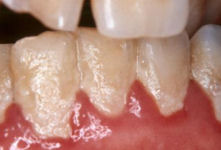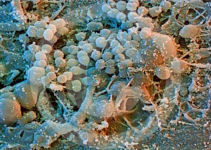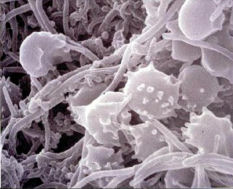
Dental Plaque
Dental plaque is an almost invisible film of bacteria that accumulates on our teeth and gums (especially in the spaces between the teeth and along the gum line). If dental plaque is not removed regularly from teeth, it can cause tooth decay and dental cavities (caries) or periodontal problems (such as gingivitis and periodontitis).
What is Dental Plaque
Dental plaque is a sticky, soft and almost colorless layer of bacteria that constantly builds up on the surfaces of teeth and gums. It is comprised of colonies of bacteria and other microorganisms mixed with bacteria by-products, saliva, dead cells and food residuals. In addition to the bacterial cells, plaque contains a small number of epithelial cells, leukocytes, and macrophages. Inorganic components are also found in dental plaque; largely calcium and phosphorus which are primarily derived from saliva.
 About 400 different species of bacteria take part in the formation of dental plaque.
A variety of different bacterial forms (cocci, rods, filaments) can be found.
It is estimated that dental plaque contains 1010 bacteria per mg.
In the intitial phases of dental plaque formation, most of them are harmless bacteria, naturally found in the mouth's normal microbial flora.
About 400 different species of bacteria take part in the formation of dental plaque.
A variety of different bacterial forms (cocci, rods, filaments) can be found.
It is estimated that dental plaque contains 1010 bacteria per mg.
In the intitial phases of dental plaque formation, most of them are harmless bacteria, naturally found in the mouth's normal microbial flora.
If dental plaque is not removed with proper oral hygiene, the bacterial layer becomes thicker and its composition changes. Bacteria strains, related with causing dental diseases, start to become dominant, and the risk of tooth decay and gum disease increases.
Types of dental plaque
The most common classification of dental plaque is based on its relative position to the gingival margin (the line where the crown of the tooth meets the gums):
- Supragingival plaque is the most common type of dental plaque covering the visible part of the teeth, and the gingival tissues.
- Subgingival plaque is accumulated under the gums and is the one most usually causing dental health problems.
Dental plaque formation
 Dental plaque formation starts almost immediately after you brush your teeth. Some minutes after brushing teeth, saliva derived glycoprotein deposits start to cover the tooth surface with what is referred to as "pellicle".
The formation of pellicle is the first step in dental plaque formation.
Dental plaque formation starts almost immediately after you brush your teeth. Some minutes after brushing teeth, saliva derived glycoprotein deposits start to cover the tooth surface with what is referred to as "pellicle".
The formation of pellicle is the first step in dental plaque formation.
The pellicle is then colonized by Gram-positive bacteria such as Streptococcus sanguis, Streptococcus mutans, and Actinomyces viscosus becoming what is known as dental plaque. Bacteria cells interact with pellicle components enabling plaque to firmly adhere to the tooth surface.
After 1 to 3 days following the initiation of plaque formation:
- the first bacteria colonies start to multiply and expand
- new bacteria species start to colonize the tooth plaque. These new species include also Gram-negative bacteria such as Fusobacterium nucleatum, Prevotella intermedia, and Capnocytophaga.
Substances produced by the already accumulated bacteria enrich the plaque environment making it favourable for the growth of other species of bacteria. One week after the first plaque accumulation, new Gram-negative species may be found, such as Porphyromonas gingivalis, Campylobacter rectus, Eikenella corrodens, Actinobacillus actinomycetemcomitans, and oral spirochetes (Treponema species).
While the dental plaque formation continues Gram-negative species become dominant over the Gram-positive species. The overgrowth of Gram-negative anaerobic bacteria is considered as one of the main causative factors of gingivitis and periodontitis. This fact increases the importance of regular dental plaque removal with tooth-brushing before the Gram-negative anaerobic bacteria have the time to grow and put your oral health at risk.
Dental health problems related to dental plaque
As the dental plaque matures, when it is not cleaned properly, its composition changes in favour of anaerobic bacteria especially at the lower layers of plaque, nearest to the tooth surface. Their anaerobic respiration produces acids which consequently lead to :
- Demineralization of the tooth enamel, which leads to tooth decay and dental cavities.
- Irritation of the gums around the teeth (gum inflammation), leading to gingivitis (red, swollen, bleeding gums), periodontal disease and tooth loss.
- Tooth plaque becomes mineralized and hardens, turning into calculus, which enables further accumulation of plaque and may promote gum recession.
- Other dental problems related to dental plaque, include bad breath and oral thrush.
Dental Plaque removal
The removal of dental plaque from teeth and gums is the first and most important step for maintaining good oral health. The best ways to remove plaque from teeth and to control plaque build up are:
- Brush thoroughly at least twice a day, with a fluoride toothpaste.
- Use dental floss at least once a day to remove plaque from interproximal spaces (between teeth) and under the gum line, where your toothbrush may not reach.
- Use plaque disclosing tablets to check your teeth after brushing to ensure proper removal of tooth plaque.
- Control your diet. Reduce the sugar uptake that helps the growth of plaque bacteria. Avoid sticky foods that are harder to clean.
- Ask your dentist or dental hygienist to check if you use the correct plaque removal techniques.
- Visit your dentist every six months for professional cleaning.
The main health problems of the oral cavity can be related to the accumulation of dental plaque on teeth. Dental plaque removal is essential for maintaining good oral health and preventing tooth decay, gum disease and other dental health problems.

